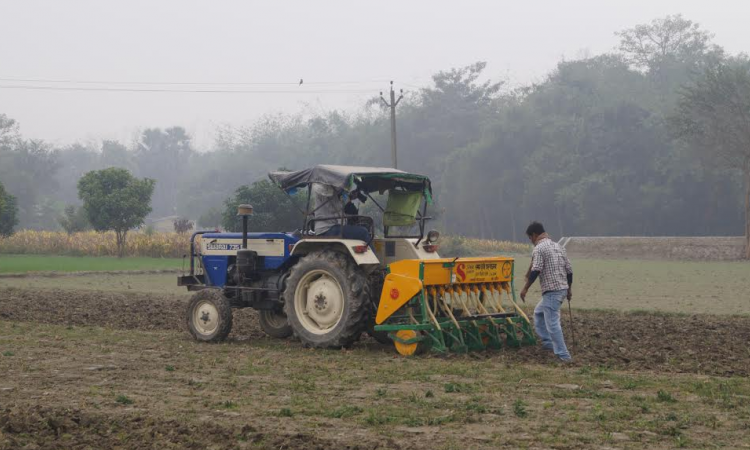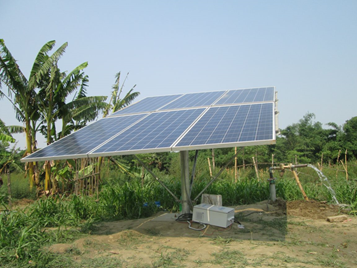
Irrigation system in India is often about big dams and hundreds of kilometres of canals that incur huge capital expenditure. Hence, policies at the central and the state level are mostly tilted in favour of big projects and often neglect micro-level solutions.
Solar water pumps, along with appropriate agricultural technologies and water conservation at the local level, have huge potential in India as they provide water for irrigation to villages at the micro level. Such local level provision for water results in less wastage and doesn't call for electric or diesel pumps thereby reducing farmers' expenditure. The government and many not-for-profits have been trying to pilot such initiatives in different parts of India. These initiatives have exposed various important issues plaguing the irrigation system in India.
The pilot of solar pumps by Sehgal Foundation in some locations of Bihar has brought out interesting facts. Solar pumps can be very useful in Bihar as most farms are not electrified and the farmers depend mostly on diesel water pumps. So Bihar Renewable Energy Development Agency has been trying to promote the use of solar pumps through schemes and subsidies. But there are only a few pumps available now and they are mainly for demonstrations. NABARD also has a capital subsidy scheme for promoting solar photovoltaic water pumping system for irrigation where 40 percent subsidy is provided. The process of accessing this subsidy, however, is complex and farmers are not aware of how to go about it which makes it unattractive to small farmers. Procedure issues in getting solar pumps need to be streamlined so that villagers can access such programmes easily (Durga, Verma, et al., 2016).
The methodology followed Sehgal Foundation follows a cluster development approach for making technology accessible to farmers. It has formed a solar pump group of 15 farm families whose fields are irrigated by one solar pump costing Rs 3 lakh. To buy this pump, one farmer contributes Rs 30,000. Sehgal Foundation provides a grant of Rs 1.5 lakh to it and Rs 1.20 lakh is leveraged from the government subsidies through effective partnership with banks and government agencies. Those members of the solar pump group who have not contributed to the capital cost buy water at the rate of Rs 40 an hour whereas the market rate of water from the diesel pump is Rs 90 an hour which increases to Rs 130 during peak seasons. But the rate of the solar pump is fixed and the money collected is used for the maintenance of the system.
Sehgal Foundation follows a cluster development approach for making technology accessible to farmers. It has formed a solar pump group of 15 farm families whose fields are irrigated by one solar pump costing Rs 3 lakh. To buy this pump, one farmer contributes Rs 30,000. Sehgal Foundation provides a grant of Rs 1.5 lakh to it and Rs 1.20 lakh is leveraged from the government subsidies through effective partnership with banks and government agencies. Those members of the solar pump group who have not contributed to the capital cost buy water at the rate of Rs 40 an hour whereas the market rate of water from the diesel pump is Rs 90 an hour which increases to Rs 130 during peak seasons. But the rate of the solar pump is fixed and the money collected is used for the maintenance of the system.
Sehgal Foundation puts a lot of emphasis on the capacity building of farmers who own solar pumps to mold them into becoming good entrepreneurs. These entrepreneurs are supported in establishing norms for the use of these pumps that can generate revenue through cost effective water-as-a-service approach. They are also trained on basic upkeep and maintenance of solar pumps and panels. They are provided training on the usage of water for different crops, micro irrigation, water harvesting in local ponds and zero tillage.
Learning new techniques
Zero tillage and laser levelling are not known to most farmers in India. Zero tillage preserves moisture in the soil thereby reducing the irrigation cycle for crops. Laser-levelling technology has huge potential to save irrigation water. It is a precision levelling technique for agricultural fields which levels the field and reduces the slope. Laser land levelling promotes water efficiency in flood irrigation and improves crop productivity. Water efficiency will reduce the cost of production. Improved productivity will enhance income, making agriculture more remunerative for marginal and smallholder farmers. Efficient water use in agriculture is also critically important for the sustainability of agriculture, particularly in water-stressed regions. Water saving in irrigation will reduce the burden on the groundwater reserve and improve water security. These technologies have the potential to save water in India.
Sehgal Foundation has piloted 14 solar pumps in East Champaran and Samastipur districts of Bihar and the experiences of farmers show that it has good potential for irrigation not only in Bihar but other parts of India with high water table. However, these methods must be combined with other water saving technologies mentioned above without which it will increase the water stress in the area.
 Cost effective, environment-friendly
Cost effective, environment-friendly
Another important aspect of solar water pumps usage is that the irrigation water is accessible at a reasonable cost to poor and marginal farmers who have to buy water from water sellers at prohibitive prices. Irrigation is a major input cost in agriculture amounting to about 70 percent of the total cost. The use of solar-powered pumps can decrease the input cost to 25 percent. For a small and marginal farmer, this is considerable and can be a game changer in making small and marginal farming more remunerative. Solar pumps are an attractive alternative technology for irrigation, which serves as a cost effective mode of irrigation with low maintenance requirements.
In addition, solar water pumps operate with zero carbon footprint. The environmental impact caused by the use of diesel pump is often not known to people. According to a study, the use of diesel-based irrigation pumps to operate wells and tube wells across India results in the emission of an estimated 3.29 million metric ton of carbon. This represents approximately one percent of India's total carbon emissions (Shah, 2009) .
Blessed with abundant groundwater resources, the major source of irrigation in Bihar is groundwater. This is mostly accessed through diesel-based pumps. According to Agricultural Census (2010-11), Bihar has 30.52 lakh hectares of net irrigated area, of which 66 percent is irrigated by wells and tube wells. The number of shallow tube wells has increased significantly in the last two decades. Their number in 2009 was estimated to be 25,267, most (46 percent) of which were owned by marginal farmers (Mukherji 2009). Ninety percent of these wells and tube wells use diesel pumps as lifting devices. Bihar, with 48 percent of India's diesel-based pumps is the primary contributor to the carbon emissions from diesel pumps in India.
So, zero carbon footprint, accessible irrigation water for poor farmers and lower cost of inputs are the important benefits of solar water pumps. The use of solar water pumps combined with the usage of appropriate technologies such as zero tillage, laser levelling and water conservation at the local level can be very useful for water and agriculture in India.
Anjali Godyal is the director of projects and Vikas Jha is the director of governance and policy advocacy at Sehgal Foundation, Gurgaon.
/articles/solar-water-pumps-efficient-irrigation